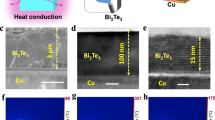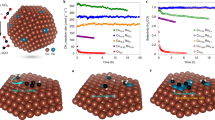Abstract
Converting carbon dioxide photocatalytically into fuels using solar energy is an attractive route to move away from a reliance on fossil fuels. Photothermal CO2 catalysis is one approach to achieve this, but improved materials that can more efficiently harvest and use solar energy are needed. Here, we report a supra-photothermal catalyst architecture—inspired by the greenhouse effect—that boosts the performance of a catalyst for CO2 hydrogenation compared to traditional photothermal catalyst designs. The catalyst consists of a nanoporous-silica-encapsulated nickel nanocrystal (Ni@p-SiO2), which is active for methanation and reverse water–gas shift reactions. Under illumination, the local temperatures achieved by Ni@p-SiO2 exceed those of Ni-based catalysts without the SiO2 shell. We suggest that the heat insulation and infrared shielding effects of the SiO2 sheath confine the photothermal energy of the nickel core, enabling a supra-photothermal effect. Catalyst sintering and coking is also lessened in Ni@p-SiO2, which may be due to spatial confinement effects.
This is a preview of subscription content, access via your institution
Access options
Access Nature and 54 other Nature Portfolio journals
Get Nature+, our best-value online-access subscription
$29.99 / 30 days
cancel any time
Subscribe to this journal
Receive 12 digital issues and online access to articles
$119.00 per year
only $9.92 per issue
Buy this article
- Purchase on Springer Link
- Instant access to full article PDF
Prices may be subject to local taxes which are calculated during checkout





Similar content being viewed by others
Data availability
The authors declare that all data supporting the findings of this study are available within the paper and Supplementary Information files. Source data are provided with this paper.
References
Rao, H., Schmidt, L. C., Bonin, J. & Robert, M. Visible-light-driven methane formation from CO2 with a molecular iron catalyst. Nature 548, 74–77 (2017).
Inoue, T., Fujishima, A., Konishi, S. & Honda, K. Photoelectrocatalytic reduction of carbon dioxide in aqueous suspensions of semiconductor powders. Nature 277, 637–638 (1979).
Wan, L. et al. Cu2O nanocubes with mixed oxidation-state facets for (photo)catalytic hydrogenation of carbon dioxide. Nat. Catal. 2, 889–898 (2019).
Qian, C. et al. Catalytic CO2 reduction by palladium-decorated silicon–hydride nanosheets. Nat. Catal. 2, 46–54 (2019).
Zhou, L. et al. Light-driven methane dry reforming with single atomic site antenna-reactor plasmonic photocatalysts. Nat. Energy 5, 61–70 (2020).
Robatjazi, H. et al. Plasmon-induced selective carbon dioxide conversion on earth-abundant aluminum-cuprous oxide antenna-reactor nanoparticles. Nat. Commun. 8, 27 (2017).
Ghoussoub, M., Xia, M., Duchesne, P. N., Segal, D. & Ozin, G. Principles of photothermal gas-phase heterogeneous CO2 catalysis. Energy Environ. Sci. 12, 1122–1142 (2019).
Xiao, J.-D. & Jiang, H.-L. Metal–organic frameworks for photocatalysis and photothermal catalysis. Acc. Chem. Res. 52, 356–366 (2019).
Jia, J. et al. Photothermal catalyst engineering: hydrogenation of gaseous CO2 with high activity and tailored selectivity. Adv. Sci. 4, 1700252 (2017).
Liu, L. et al. Sunlight-assisted hydrogenation of CO2 into ethanol and C2+ hydrocarbons by sodium-promoted Co@C nanocomposites. Appl. Catal. B Environ. 235, 186–196 (2018).
Wang, X., Wang, F., Sang, Y. & Liu, H. Full-spectrum solar-light-activated photocatalysts for light-chemical energy conversion. Adv. Energy Mater. 7, 1700473 (2017).
Ning, S. et al. Microstructure induced thermodynamic and kinetic modulation to enhance CO2 photothermal reduction: a case of atomic-scale dispersed Co–N species anchored Co@C hybrid. ACS Catal. 10, 4726–4736 (2020).
Yang, M. Q., Gao, M., Hong, M. & Ho, G. W. Visible-to-NIR photon harvesting: progressive engineering of catalysts for solar-powered environmental purification and fuel production. Adv. Mater. 30, 1802894 (2018).
Meng, X. et al. Photothermal conversion of CO2 into CH4 with H2 over Group VIII nanocatalysts: an alternative approach for solar fuel production. Angew. Chem. Int. Ed. 53, 11478–11482 (2014).
Sastre, F., Puga, A. V., Liu, L., Corma, A. & García, H. Complete photocatalytic reduction of CO2 to methane by H2 under solar light irradiation. J. Am. Chem. Soc. 136, 6798–6801 (2014).
Chen, G. et al. Alumina-supported CoFe alloy catalysts derived from layered-double-hydroxide nanosheets for efficient photothermal CO2 hydrogenation to hydrocarbons. Adv. Mater. 30, 1704663 (2018).
Hoch, L. B. et al. Nanostructured indium oxide coated silicon nanowire arrays: a hybrid photothermal/photochemical approach to solar fuels. ACS Nano 10, 9017–9025 (2016).
Yu, F. et al. Enhanced solar photothermal catalysis over solution plasma activated TiO2. Adv. Sci. 7, 2000204 (2020).
Mateo, D., Albero, J. & García, H. Titanium-perovskite-supported RuO2 nanoparticles for photocatalytic CO2 methanation. Joule 3, 1949–1962 (2019).
Wang, L. et al. Black indium oxide a photothermal CO2 hydrogenation catalyst. Nat. Commun. 11, 2432 (2020).
Montoya, J. H. et al. Materials for solar fuels and chemicals. Nat. Mater. 16, 70–81 (2016).
Kumar, B. et al. Photochemical and photoelectrochemical reduction of CO2. Annu. Rev. Phys. Chem. 63, 541–569 (2012).
Gust, D., Moore, T. A. & Moore, A. L. Solar fuels via artificial photosynthesis. Acc. Chem. Res. 42, 1890–1898 (2009).
Zhang, S. et al. A general and mild route to highly dispersible anisotropic magnetic colloids for sensing weak magnetic fields. J. Mater. Chem. C 6, 5528 (2018).
Ozin, G. A. Throwing new light on the reduction of CO2. Adv. Mater. 27, 1957–1963 (2015).
Gao, W. et al. Photo-driven syngas conversion to lower olefins over oxygen-decorated Fe5C2 catalyst. Chem 4, 2917–2928 (2018).
Mao, C. et al. Beyond the thermal equilibrium limit of ammonia synthesis with dual temperature zone catalyst powered by solar light. Chem 5, 2702–2717 (2019).
Chen, Y. Z. et al. Singlet oxygen-engaged selective photo-oxidation over Pt nanocrystals/porphyrinic MOF: the roles of photothermal effect and Pt electronic state. J. Am. Chem. Soc. 139, 2035–2044 (2017).
O’Brien, P. G. et al. Photomethanation of gaseous CO2 over Ru/silicon nanowire catalysts with visible and near-infrared photons. Adv. Sci. 1, 1400001 (2014).
Kho, E. T. et al. A review on photo-thermal catalytic conversion of carbon dioxide. Green. Energy Environ. 2, 204–217 (2017).
Li, K. et al. Balancing near-field enhancement, absorption, and scattering for effective antenna–reactor plasmonic photocatalysis. Nano Lett. 17, 3710–3717 (2017).
Hogan, N. J. et al. Nanoparticles heat through light localization. Nano Lett. 14, 4640–4645 (2014).
Baffou, G. et al. Photoinduced heating of nanoparticle arrays. ACS Nano 7, 6478–6488 (2013).
Richardson, H. H., Carlson, M. T., Tandler, P. J., Hernandez, P. & Govorov, A. O. Experimental and theoretical studies of light-to-heat conversion and collective heating effects in metal nanoparticle solutions. Nano Lett. 9, 1139–1146 (2009).
Feng, K. et al. Cobalt plasmonic superstructures enable almost 100% broadband photon efficient CO2 photocatalysis. Adv. Mater. 32, 2000014 (2020).
Zhou, S. et al. Pd single-atom catalysts on nitrogen-doped graphene for the highly selective photothermal hydrogenation of acetylene to ethylene. Adv. Mater. 31, 1900509 (2019).
Song, H., Meng, X., Wang, Z.-j, Liu, H. & Ye, J. Solar-energy-mediated methane conversion. Joule 3, 1606–1636 (2019).
Li, Z. et al. Photothermal hydrocarbon synthesis using alumina-supported cobalt metal nanoparticle catalysts derived from layered-double-hydroxide nanosheets. Nano Energy 60, 467–475 (2019).
Li, Y. et al. Selective light absorber-assisted single nickel atom catalysts for ambient sunlight-driven CO2 methanation. Nat. Commun. 10, 2359 (2019).
Zhou, Y. et al. Photothermal catalysis over nonplasmonic Pt/TiO2 studied by operando HERFD-XANES, resonant XES, and DRIFTS. ACS Catal. 8, 11398–11406 (2018).
Li, Z. et al. Co-based catalysts derived from layered-double-hydroxide nanosheets for the photothermal production of light olefins. Adv. Mater. 30, 1800527 (2018).
Han, X., Song, L., Xu, H. & Ouyang, S. Light-driven low-temperature syngas production from CH3OH and H2O over a Pt@SrTiO3 photothermal catalyst. Catal. Sci. Technol. 8, 2515–2518 (2018).
Ren, J. et al. Targeting activation of CO2 and H2 over Ru-loaded ultrathin layered double hydroxides to achieve efficient photothermal CO2 methanation in flow-type system. Adv. Energy Mater. 7, 1601657 (2016).
Li, X., Zhang, X., Everitt, H. O. & Liu, J. Light-induced thermal gradients in ruthenium catalysts significantly enhance ammonia production. Nano Lett. 19, 1706–1711 (2019).
Joo, S. H. et al. Thermally stable Pt/mesoporous silica core–shell nanocatalysts for high-temperature reactions. Nat. Mater. 8, 126–131 (2009).
Park, J. N. et al. Highly active and sinter-resistant Pd-nanoparticle catalysts encapsulated in silica. Small 4, 1694–1697 (2008).
Wu, Z. et al. Niobium and titanium carbides (MXenes) as superior photothermal supports for CO2 photocatalysis. ACS Nano 15, 5696–5705 (2021).
Dong, C. et al. Size-dependent activity and selectivity of carbon dioxide photocatalytic reduction over platinum nanoparticles. Nat. Commun. 9, 1252 (2018).
Huang, H. et al. Solar-light-driven CO2 reduction by CH4 on silica-cluster-modified Ni nanocrystals with a high solar-to-fuel efficiency and excellent durability. Adv. Energy Mater. 8, 1702472 (2018).
Liu, H. et al. Light assisted CO2 reduction with methane over SiO2 encapsulated Ni nanocatalysts for boosted activity and stability. J. Mater. Chem. A 5, 10567–10573 (2017).
Zhu, L., Gao, M., Peh, C. K. N. & Ho, G. W. Solar-driven photothermal nanostructured materials designs and prerequisites for evaporation and catalysis applications. Mater. Horiz. 5, 323–343 (2018).
Yu, S., Wilson, A. J., Kumari, G., Zhang, X. & Jain, P. K. Opportunities and challenges of solar-energy-driven carbon dioxide to fuel conversion with plasmonic catalysts. ACS Energy Lett. 2, 2058–2070 (2017).
Acknowledgements
We acknowledge the support from the National Natural Science Foundation of China (51920105005, 51802208, 21902113, 51821002, 91833303), the Natural Science Foundation of Jiangsu Province (BK20200101), 111 project and the Collaborative Innovation Centre of Suzhou Nano Science & Technology. G.A.O. is grateful to the Natural Sciences and Engineering Council of Canada for support of this work.
Author information
Authors and Affiliations
Contributions
L.H., G.A.O. and X.Z. conceived the idea and supervised the project. M.C., Z.W., W.S. and W.L. carried out the preparation of materials. M.P., S.W., L.W., K.F. and A.S.H. contributed to the characterizations. M.C., Z.W., Z.L. and L.W. performed the catalytic testing. M.C., A.T. and C.L. contributed to the calculation of the Tlocal of catalysts. All authors discussed the results and co-wrote the manuscript.
Corresponding authors
Ethics declarations
Competing interests
The authors declare no competing interests.
Additional information
Peer review information Nature Energy thanks Hermenegildo Garcia and the other, anonymous, reviewer(s) for their contribution to the peer review of this work.
Publisher’s note Springer Nature remains neutral with regard to jurisdictional claims in published maps and institutional affiliations.
Supplementary information
Supplementary Information
Supplementary Figs. 1–34, Tables 1–3, Notes 1–2 and references.
Source data
Source Data Fig. 1
Statistic source data.
Source Data Fig. 5
Statistic source data.
Rights and permissions
About this article
Cite this article
Cai, M., Wu, Z., Li, Z. et al. Greenhouse-inspired supra-photothermal CO2 catalysis. Nat Energy 6, 807–814 (2021). https://doi.org/10.1038/s41560-021-00867-w
Received:
Accepted:
Published:
Issue Date:
DOI: https://doi.org/10.1038/s41560-021-00867-w
This article is cited by
-
Solar-driven photothermal catalytic CO2 conversion: a review
Rare Metals (2024)
-
Hybrid structure of iron single atoms and metallic titanium for photothermal ethanol steam reforming
Science China Chemistry (2024)
-
Cu-based high-entropy two-dimensional oxide as stable and active photothermal catalyst
Nature Communications (2023)
-
Photocatalytic CO2 reduction
Nature Reviews Methods Primers (2023)
-
Photothermal recycling of waste polyolefin plastics into liquid fuels with high selectivity under solvent-free conditions
Nature Communications (2023)



